I have a dataframe pivot table with 2 level of index: month and rating. The rating should be 1,2,3 (not to be confused with the columns 1,2,3). I found that for some months, the rating could be missing. E.g, (Population and 2021-10) only has rating 1,2. I need every month to have ratings 1,2,3. So I need to fill 0 for the missing rating index.
tbl = pd.pivot_table(self.df, values=['ID'], index=['month', 'risk'],
columns=["Factor"], aggfunc='count', fill_value=0)
tbl = tbl.droplevel(None, axis=1).rename_axis(None, axis=1).rename_axis(index={'month': None,
'Risk': 'Client Risk Rating'})
# show Low for rating 1, Moderate for rating 2, Potential High for rating 3
rating = {1: 'Low',
2: 'Moderate',
3: 'Potential High'
}
pop = {'N': 'Refreshed Clients', 'Y': 'Population'}
tbl.rename(index={**rating,**pop}, inplace=True)
tbl = tbl.applymap(lambda x: x.replace(',', '')).astype(np.int64)
tbl = tbl.div(tbl.sum(axis=1), axis=0)
# client risk rating may be missing (e.g., only 1,2).
# To draw, need to fill the missing client risk rating with 0
print("before",tbl)
tbl=tbl.reindex(pd.MultiIndex.from_product(tbl.index.levels), fill_value=0)
print("after pd.MultiIndex.from_product",tbl)
I have used pd.MultiIndex.from_product. It does not work when all data is missing one index. For example, population has Moderate, 2021-03 and 2021-04 have Low and Moderate. After pd.MultiIndex.from_product, population has Low and Moderate, but all are missing High. My question is to have every month with risk 1,2,3. It seems the index values are from data.


